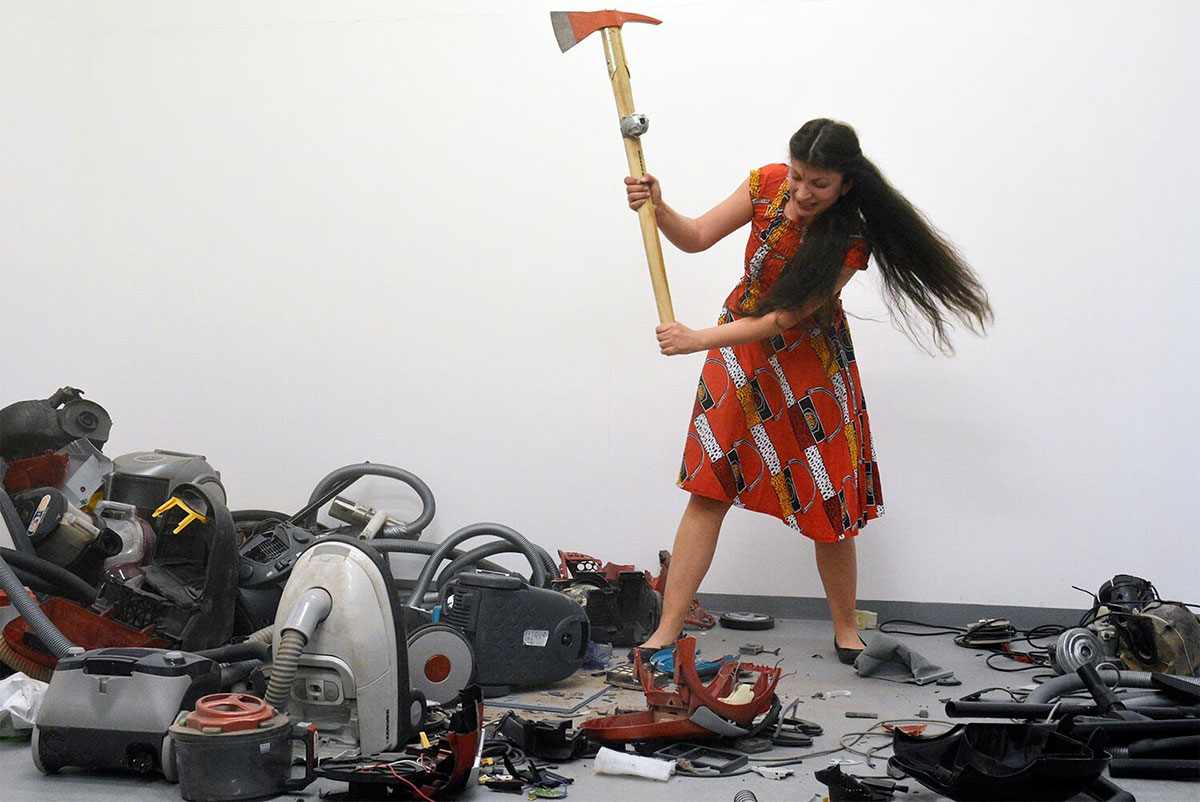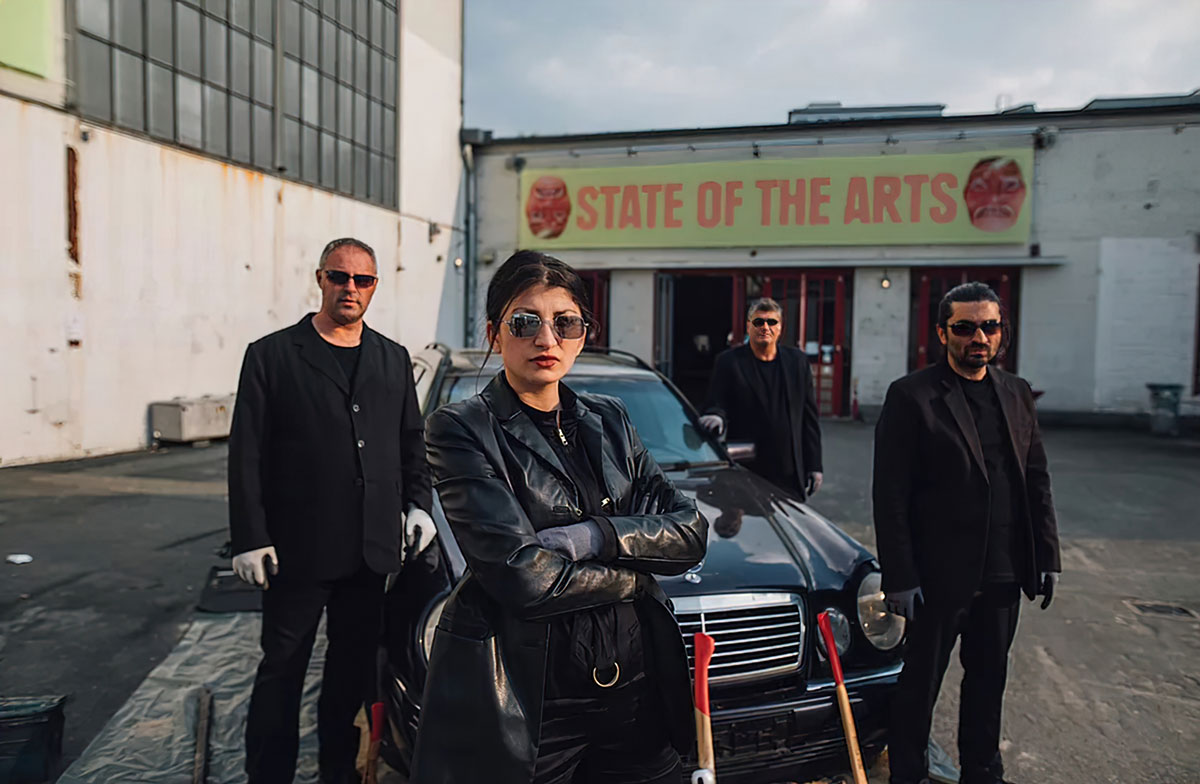1. New works by “the most dangerous woman in the world”
Only a few years ago, she boldly and confidently entered into the spotlight of the international art world, describing herself as “the most dangerous woman in the world.” Together with her family, Selman disassembles former status symbols like Mercedes-Benz cars in front of an audience, in order to acquire the few precious metals that are still usable. The spoken performances by this artist with a Roma background are usually loud, for she gives expression to anger and her urge to reverse power relationships. In a variety of media, Selman’s art explores experiences of discrimination, violence, sexism, and patriarchy in a striking way. Her multilayered work comprises performances, sculptures, paintings on car parts and scrap metal, drawings, and video.
At the SCHIRN, the artist presents prints, small sculptural works made from precious metals, and two performances that pick up on central themes of her oeuvre, as well as two newly created works. The installation “Flowers of Life” (2024), made from multipronged grabs, gestures to her family’s livelihood, which involves collecting and reselling scrap metal. The film “Crossing the Blue Bridge” (2024) is based on her mother’s memories of experiences in her hometown of Bihać during the Bosnian War (1992– 95).

Photo: Selma Selman’s Archive, Image via dreamidreamachine.com

Selma Selman, Mercedes Matrix, 2019, Performance © Selma Selman, Photo: Mario Ilic, Image via dreamidreamachine.com
2. Giant machines turn into flowers
The exhibition centers around the newly conceived work “Flowers of Life” (2024), which gives the exhibition its title. This expansive installation consists of four used multipronged grabs, typically found on construction sites and scrap yards. In Selma Selman’s appropriation, the massive machines are transformed into flower-like kinetic sculptures powered by a motor, their blossoms slowly opening and closing. Inside, they reveal paintings by the artist. “Flowers of Life” ties in with Selman’s well-known works with scrap metal, “Paintings on Metal” (since 2014), which oscillate between painting and sculpture and refer to her family’s scrap metal trade. The sensual, floral interpretation of “Flowers of Life” reverses masculine and feminine connotations, at the same time revealing women as the key driving force of the community. With strong and defiant formal language, Selman reinterprets stigmatizing stereotypes that the social majority has constructed around Roma culture and the role of women.

Selma Selman, Motherboards (The Wedding), 2023, acrylic on scrap metal, Courtesy: the artist and Rijksakademie; Photo: Sander van Wettum, Image via frieze.com
3. Visibility and emancipation as a Roma woman
Selman’s origins and the inclusion of her family in her artistic practice form an integral part of her work. The intensive collaboration with her mother especially revolves around autobiography, visibility, and emancipation as a Roma woman, and has already been reflected in numerous works. The SCHIRN presents the new film “Crossing the Blue Bridge” (2024; 27:15 min.) in a two-screen installation. “Crossing the Blue Bridge” examines the lingering effects of historical trauma, as well as care, courage, and resistance. Selman inhabits the role of her mother and reenacts her memories.
The film is based on her mother’s experiences during the Bosnian war: On a day during a ceasefire in 1994, her mother went into town with Selman’s sister to find food. On the way home, they had to cross Bihać’s Alija Izetbegović Bridge, also called the Blue Bridge, which was strewn with corpses and animal carcasses. While trying to simultaneously cover her child’s eyes and carry the heavy basket of food, the strong winds blew her hair around her face, obscuring her view. Selman recreates this image in her film, linking it to figures from Greek mythology, among others, in a hauntingly recited text in English, Bosnian, and Romani. She stylizes her mother as a heroine who is partially responsible for her daughter’s ability to cope under the most adverse conditions in today’s world. The Blue Bridge transforms into a symbol of Selman’s artistic activism, which she uses to create new paths.

4. An intersectional view of the self
“Superpositional Intersectionalism – Sleeping Guards” (2023–ongoing), a series of sixteen colored pencil drawings on round paper, revolves around Selman’s self-portrait. The drawings depict intimate observations of female figures whose faces and bodies metamorphose into surreal hybrids with fluid identities, expanding and taking on abstract forms. The penetrating gaze of an eye, a recurring motif in Selman’s work resurfaces in these pictures as a reference to identity and social systems of codification. Here, too, Selman addresses the possibilities and limitations of what she can be— a woman, an artist, a Roma person, an internationally successful star, a daughter, a Muslim, a European. The title combines the quantum physics phenomenon of superposition, which describes how an atom can be in different states at the same time, with the concept of intersectionality, which refers to the confluence of several forms of discrimination.


5. Live performances: Selma Selman in action
Two live performances by the artist will take place over the course of the exhibition. For the opening of the exhibition, Selman will present “You Have No Idea” (since 2015). Depending on the situation, the haunting performance can last between just five minutes and an hour and a half. With her continuous repetition of the phrase that gives the piece its title, she addresses social classification and confronts the audience with their subconscious assumptions about other people. In a reading Selman will perform the work “Letters to Omer” (since 2021). In the ongoing series of letters, which she is continuously publishing on her instagram account, the artist shares intimate thoughts, wishes, and visions of a possible future with a fictional character named Omer.

